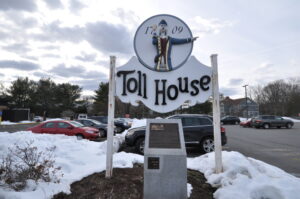By Sharon Oliver, Contributing Writer

WHITMAN – Crowned the official state cookie of the Commonwealth in 1997, chocolate chip cookies have been satisfying the sweet tooth of millions of people since their creation by Walpole native Ruth Graves Wakefield in the 1930s.
Created at a well-known inn
After Wakefield graduated from Framingham State Normal School Department of Household Arts, she went on to work as a dietician. In 1930, she and her husband Kenneth Wakefield purchased a Cape-Cod style house in Whitman on Route 18, a busy state highway that wends its way down much of the South Shore. Historically (or mythically) it was noted as a lodge where passengers would pay a toll, feast on home-cooked meals and change horses. Reportedly, the inn was never a “toll house” and the term was used as a marketing strategy. Nevertheless, the couple named their tourist lodge The Toll House Inn. Not long afterwards, the inn gained popularity for Ruth Wakefield’s desserts, with then-Senator John F. Kennedy among its frequent visitors.
Sometime around 1938, Wakefield invented the chocolate chip cookie. There were sources who claimed the invention was all a happy accident after Wakefield ran out of nuts for a recipe. Another version that floated around was that a chocolate bar broke and fell in the dough. However, Wakefield disputed the rumors and stated it was no accident but a deliberate effort.
According to “The Great American Chocolate Chip Cookie Book: Scrumptious Recipes & Fabled History from Toll House to Cookie Cake Pie,” by Carolyn Wyman, Wakefield said, “We had been serving a thin butterscotch nut cookie with ice cream. Everybody seemed to love it, but I was trying to give them something different. So, I came up with Toll House cookie.”
Popularity grows

Wakefield’s now famous mix of melted chocolate chunks and crispy cookies first appeared in her cookbook “Tried and True” and was meant to complement a serving of ice cream. The recipe became so popular it was featured on Marjorie Husted’s (aka Betty Crocker) radio program in her “Famous Foods from Famous Eating Places” series.
After America’s entry into the Second World War, Toll House cookies were often part of care packages sent to boost the morale of soldiers from Massachusetts who were serving overseas. Word of the delicious cookies spread after being shared with other GIs. In fact, hundreds of soldiers wrote home asking their families to send them Toll House cookies, and Wakefield received letters from around the world asking for the recipe. Before the war, the cookies were largely an East-Coast based treat. By 1939, Wakefield sold the rights to use her recipe and the Toll House name to Nestle for one dollar, which she later said was never received. Also, as part of the bargain, she was given free chocolate for life and worked as a paid consultant for Nestle.
From homemade to mass-produced
During the postwar years, the chocolate chip cookie traveled the same route as other culinary innovations: from homemade to mass-produced, from kitchens to factories and from fresh to franchised. Other brands like Nabisco’s Chips Ahoy, Famous Amos, and Mrs. Fields were launched. Nestle did include Wakefield’s recipe on the back of their semi-sweet chocolate bars and created Toll House Morsels to make it easier for bakers to help fuel the growing trend of baking chocolate chip cookies in the home.
The Wakefields successfully ran the Toll House inn and restaurant from 1930 to 1967. Sadly, the Toll House burned down on New Year’s Eve in 1984 and the site is marked by a sign and plaque nestled between a Walgreens and Wendy’s. Ruth Wakefield, who likely never imagined her recipe created in a Massachusetts inn so many years ago would see worldwide fame, died in 1977 at age 73.
RELATED CONTENT:
Boston baked beans have stood the test of time (fiftyplusadvocate.com)
Our fondness for fluffernutter is forever (fiftyplusadvocate.com)
Nothing said Yankee comfort food like Durgin-Park (fiftyplusadvocate.com)












